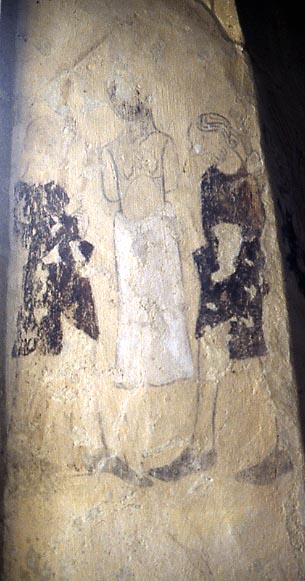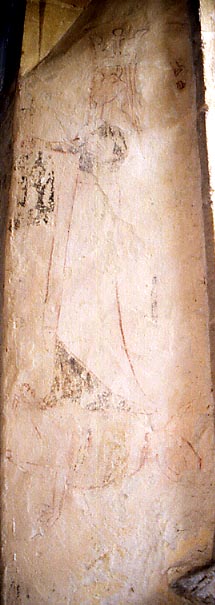Stoke Dry, Rutland (†Peterborough) C.14
Martyrdom of St Margaret

On the right is St Margaret of Antioch being beaten with staves and scourges, one of the many tortures decreed by the Roman Governor Olybrius for her when she refused to give up her Christianity and succumb to his seduction attempts. The Saint stands¹ frontally in the centre, stripped to the waist, with torturers on either side. Both hands of the one on the left can be seen, but the stave or club held in them has almost disappered. The short, thick club of the one on the right is clearer, held at shoulder level on the torturer’s right as if poised for a backhand blow.

Margaret was triumphant in the end; after many other tortures, culminating in her being swallowed by a dragon, she succeeded in bursting out of its swollen innards, and in some versions of her Legend she then leads it tethered by her girdle. I think that is what is happening in the painting in the window-splay opposite the one above and pictured here at the left. The painting is now very faint and fragmentary indeed, but Margaret’s tall figure, now crowned, can be seen. In her left hand she may hold (diagonally across her body) the cross which helped her to escape from the dragon. Her right arm is extended and, although I cannot see the girdle, Margaret is standing on a very faint pig-like creature, mouth (on the left) apparently gaping wide like a miniature Mouth of Hell, with one leg ending in a dragon-like clawed foot and a hint of a long, coiling tail.
Although a few paintings of St Margaret still exist in the English church, all of them are damaged, some to the point of near-indecipherability. The sequence at Battle Abbey is said to be the best-preserved; I have not seen it, but in the table below are other paintings of St Margaret – and that at Charlwood is remarkably complete, with only a few details missing.
Stoke Dry has other paintings, including a St Christopher, a Martyrdom of St Edmund (both in the chantry chapel close to St Margaret), and the far less common Martyrdom of St Andrew (in the chancel, on the left-hand side of the altar wall).
Website for St Andrew’s, Stoke Dry
¹ Or she may be hanging by her hair, as decreed by Olybrius and shown at Ashby St Ledgers and Duxford linked in the table below and also at Little Kimble (forthcoming and previewed on the page for Duxford). In this new photograph faint traces of her white feet dangling below the hem of her robe suggest that she is, but details of the suspension mechanism above her head have effectively disappeared now. [Footnote added November 2009]